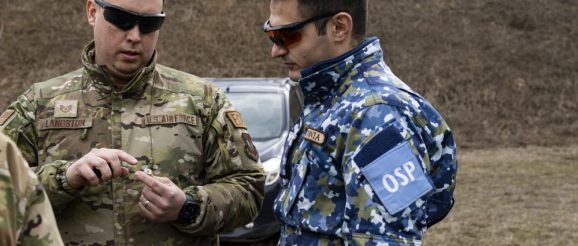DVIDS – News – 480th EFS EOD personnel test new asset-saving innovation

Photo By Senior Airman Ali Stewart |
U.S. Air Force Tech. Sgt. William Langston, 480th Expeditionary Fighter Squadron……
read more
read more
A new Explosive Ordnance Disposal technique is being tested while the 480th Expeditionary Fighter Squadron from Spangdahlem Air Base, Germany, is deployed to the 86th Air Base.
U.S. Air Force Tech Sgt. William Langston and Senior Airman Stephen Maloy, 480th EFS EOD technicians, came up with a new innovation that completely eliminates the need for C-4 explosives to dispose of expired and or damaged ordnance.
Traditionally, C-4 explosives are used in a controlled environment on a range to rid of expired or damaged ordnance. In this instance, a device used in the F-16 Fighting Falcon responsible for setting off the flares on the aircraft, known as the CCU-41/B, was found to have a small amount of corrosion and therefore couldn’t be used or stored on the Romanian installation.
“Once a CCU-41/B went bad we had no other choice but to use C-4 and a blasting cap to dispose of it,” said Langston. “In most cases this is not a big deal, but being on NATO’s most eastern front with only ten electric blasting caps for the many issues that could arise, using one of our ten assets would quickly dwell our stockpile, and is a waste of much needed resources.”
In order to meet host nation requirements, any unserviceable munitions cannot be stored on the installation and must be disposed of.
“Once the second CCU-41/B went bad we realized very quickly that this current course of action could not continue and still be able to fully support the mission with limited demolition explosives.”
Maloy spent some time researching different ways to fix this issue, and during his research he found a possible solution.
“I came across a line that read the aircraft uses a lot of volts to set off the CCU-41/B,” said Maloy. “After reading it, the idea was the same across our minds, ‘let’s do that, let’s use lots of volts’.”
By using electrical tape to ensure connections are maintained, and connecting a wire to attach from the CCU-41/B directly to a remote firing device, the charge can replicate the way an F-16 would trigger the flares.
“We then reached out to aircraft maintenance, equipment, weapons, and ammo to comb through their publications and see exactly how many volts and amps we needed to function the item as designed,” said Langston. “The search did not go well at first until we ended up finding some manufacturer’s data that said we needed five amps to fire the CCU-41/B, but no data could be found on the exact volts.”
Langston and Maloy reached out to the EOD’s Technical Service Center and proposed the use of the firing devices to attach to the CCU-41/B and supply the amps needed to trigger the explosion.
“The TSC then reached out to the scientists that conducted the original tests on the CCU-41/B and had them review the request and compare it to the tests they already had on it,” said Langston. “In less than a day we had an answer that the proposed procedure should work as long as the item itself was undamaged.”
The EOD team has successfully tested this procedure without any failures three times now.
Langston and Maloy hope to elevate this procedure to the higher levels of the EOD community in order to enhance Agile Combat Employment operations everywhere.
“I do believe as agile combat employment and enhanced air policing missions continue, EOD will find themselves in similar situations and having options that can limit the number of resources used is vital to the success of the mission,” said Langston. “More testing will have to go into this procedure to ensure its success and the safety of our EOD technicians in the field.”
Small innovations such as these are pivotal to ensuring NATO’s mission can be completed during contingency operations in any type of environment , while using our resources strategically to ensure we can continue our mission for extended periods of time.
| Date Taken: | 03.19.2022 |
| Date Posted: | 03.23.2022 04:13 |
| Story ID: | 416983 |
| Location: | FETESTI, RO |
| Web Views: | 8 |
| Downloads: | 0 |
